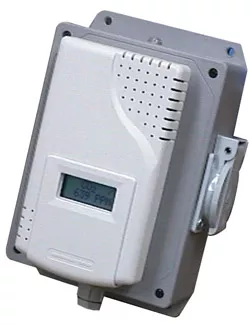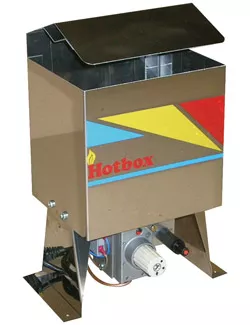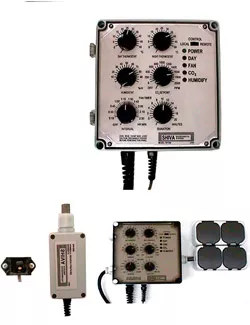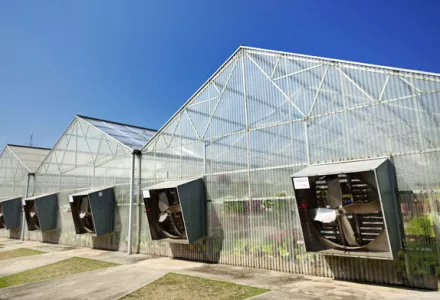It’s well-known that plants use macro and micro nutrients for tissue development and good biological progress. However on occasions we forget that carbon is also one of the necessary elements for the life of plants, and all organisms – of course.
Not only are essential elements made up of carbon but so are desired metabolites like those in sensory properties such as aroma and flavour. A lack of carbon would not only result in a lower biomass but the plants would also be of inferior quality and strength. This precious element is absorbed through the plants’ stomata in gas form, carbon dioxide (CO2), and transformed through capturing energy in the form of light energy in a process known as photosynthesis. The final result is a large quantity of carbon hydrates and other essential components for good plant growth and development.
You can achieve a higher rate of photosynthesis by controlling the variables that affect the photosynthetic processes – light intensity and stomata opening, temperature and ambient CO2 levels – and therefore growth in the compound formation that accelerates the plant’s metabolism and therefore the desirable processes including but not limited to the production and taste.
Generally CO2 is one of the minority air gases. It is normally in a 300 ppm concentration, but is constantly increasing due to the use of fossil energy combustion. In a natural open environment these levels remain constant, but large variations can occur in enclosed areas such as greenhouses and cultivation rooms. As the plants grow, their demand for CO2 increases because the amount of biomass is increasing, so if the correct air renewal is not provided at moments of high temperature, e.g. at midday, the CO2 concentrations can drop to critical levels.
One of the methods we can use to maintain constant CO2 levels is good air renewal. Have extractors remove the air lacking in CO2 and good air intakes or fans that allow new air to flow in. Bearing this in mind, it’s evident that an extractor with sufficient power to guarantee the plants’ correct development is required. But plants can tolerate and absorb greater CO2 levels and we can therefore use it to increase the plant’s photosynthetic rate and in this way process a larger quantity of desirable metabolites.
It is believed this reaction is due to plants having evolved millions of years ago when the earth’s atmosphere was much richer in CO2 than now, and although the current levels are sufficient, in actual fact plants grew and evolved in environments much richer in CO2.
Effects of increasing CO2 concentration

Although a plant can perfectly tolerate levels between 1500 and 2500 ppm, in practice levels do not usually even reach 900 or 1000 ppm. In all the biological machinery involved in the exploitation of the air’s carbon, one of the most important enzymes is rubisco which is combined with CO2 to activate sugar formation. But this enzyme also has an affinity to combine with oxygen and when this happens, some of the CO2 absorbed is not used. CO2 levels of 1000 ppm are sufficient to block the effect of rubisco oxygenation and photorespiration, and at such CO2 levels the stomata absorb more and make more effective use of CO2.
When CO2 levels rise, the ideal photosynthesis temperature also rises, which is why temperatures around 26°C are beneficial and this is the ideal temperature for your cultivation room. Photosynthesis rates also increase with more intensive light, so you get better results with greatly increased light intensities. In other words you won’t notice “extraordinary” results if you don’t use high powered discharge lamps (600W to 1000W).
Another effect which is going to determine the plants’ correct absorption of water and nutrients in CO2 rich environments is lowering transpiration to 40%. It could be said that transpiration is the physiological cost of photosynthesis. Remember that the transportation of water and therefore of the nutrients through the plant is carried out by the tension caused by these transpiration phenomena. Water evaporates through the stomata creating a tension that causes the roots to absorb new water molecules from their surroundings. When transpiration diminishes, the absorption of water and thus also nutrients also decreases.
So how can we ensure that the plant’s growth improves if its water intake is limited? The answer is that photosynthetic use of water is more efficient in CO2 rich environments. But even if we can influence the environment and reduce transpiration, we will still have a growing environment with very high ambient humidity. And even if the water is utilized better, the amount absorbed by the roots will still be less and therefore the fewer nutrients will be entering the plant. This in turn will reduce the rate at which nutrients are transported through the plant and this can be particularly detrimental to the transport of low mobility elements such as calcium.
The next aspect we have to consider is the need to increase concentrations of nutrients, also in response to the plant’s increased metabolic rate which requires a higher nutrient input in CO2 rich environments. This is why when we bathe our plants in CO2 we encounter another limiting factor which is difficult to regulate: the excess humidity should be expelled by our extraction system to maintain optimum humidity levels for correct transpiration and also for preventing fungicidal diseases, such as botrytis, which will destroy the yield. However, the extractor will not only remove the excessive humidity but it will also remove the extra CO2 added, so we’re back to square one! In the next paragraph we’ll look at some different and hopefully more efficient systems to administer extra CO2.
Methods for administering CO2

We can classify methods for administering CO2 to plants into two groups, that is hot or cold techniques. Hot techniques employ gas combustion to generate CO2 and also heat. The method is excellent in extremely cold environments, where the extra heat is also needed to achieve temperatures suitable for growing.
Generating CO2 via combustion has an added inconvenience – one of the by-products is water vapour! That extra humidity from the combustion is harmful in the advanced stages of blooming, when it is essential to have low humidity levels.
Cold gas techniques
Cold techniques include methods where CO2 comes from compressed gas cylinders or from chemical reactions, such as fermentation or dry ice. These two methods are attractive considering they are fairly safe and relatively cheap. Don’t be surprised if the cost of a gas cylinder system with controller and regulator is beyond your budget! In certain circumstances fermentation or dry ice may be insufficient. Their slow and/or scarce CO2 emission, plus fact that it is almost impossible to regulate a stable flow, means that you never get up to the levels needed to produce great results or if you do, the extra CO2 is just too late to make a difference.
This method has other drawbacks: when you connect extractors to expel the humidity generated by your plants’ transpiration (remember what we said earlier about maintaining low levels of relative humidity, especially in blooming periods) the CO2 generated would also be extracted. So you would have to wait until the CO2 levels were correct again and many of these systems do not feature rapid gas generation. However they do not stop contributing extra CO2 which could sometimes produce favourable results.
If you do use one of these methods, you should be clear about the quantity of CO2 they generate before purchasing or using them, and maybe most importantly, the speed at which they generate CO2, so you can make your calculations and apply them to your cultivation.
A gas cylinder system
As we have seen, the main obstacle for CO2 fertilization is ventilation at times of high humidity. Taking this into consideration the most effective method is a gas cylinder system with controllers and regulators. These systems are more expensive but above all much safer and more effective as they are capable of achieving and replacing the desired CO2 levels in a short space of time.
Also the possibility of connecting regulators allows a constant concentration with hardly any variations. This aspect is important as unstable CO2 levels throughout the cultivation mean continuous readjustment of the other parameters involved (temperature, humidity, nutrients, etc) to ensure that the carbon dioxide fertilization was really effective and safe. Apart from a regulator, a CO2 measuring gauge is also very important. Remember that CO2 is a colourless, odourless, asphyxiant gas and the human exposure tolerance is around 0.5%.
So we would not recommend using CO2 gas cylinder methods without a good regulator that enables you to control the amount of CO2 released as well as a gauge that tells you the CO2 level in your cultivation room. The measuring probe should be inside the cultivation room and the indicator screen should be located outside, so that you can turn the cylinder on or off without having to enter your cultivation room. Needless to say there are mechanisms on the market that start the extractors when a specified humidity level of is reached.
The most important thing is to have a system that shuts off CO2 emission when the extractors are started on reaching the desired humidity limits to avoid gas waste. The gas supply must also be shut off during hours of darkness.

Obviously the ventilation system must have good ventilators to avoid CO2 stratification in the lower levels of the cultivation room owing to the greater weight of the carbon dioxide compared to other gases. Because of this, CO2 emission should generally be in the upper part of the cultivation area. Also consider that the gas released from a gas pressure cylinder is cold and this will lower the temperature, which may even be beneficial in extremely warm periods.
Cold water techniques
Another method we can consider is carbon dioxide ferti-irrigation, which is administering through watering. A method to enrich the irrigation water with CO2 is by injecting the gas in the water under pressure.
Nutrients are almost always added after the CO2. You can achieve various benefits using this system, but the actual reasons and the mechanism in the plant is not yet fully understood. Some studies indicate that the advantages of carbon dioxide ferti-irrigation are derived from the capacity the CO2 has to acidify when dissolved in water, as it quickly turns into carbonic acid. This acidification is beneficial for the absorption of certain nutrients which would otherwise be blocked at certain times due to the properties of the cultivation ground. Certain micro organisms that benefit the soil would also gain from this acidification.
Whatever the reason, these benefits are not the product of greater assimilation or acquisition of CO2.
CO2 good for parents too
Lastly I would like to point out that when we talk of CO2 we always consider our
blooming room and the general benefits it has on the yield, but we should not forget the great advantages CO2 offers in our valuable mother plant room. Owing to the fact that adding extra CO2 produces a growth and speeds up biomass formation, a 20-30% increase in cuttings from the mother plant can be obtained in the same space of time, with the consequent saving of space this represents. Also a growing room does not require such strict humidity control as the blooming room. Furthermore, in intensive hydroponic cultivation or where the addition of organic material is poor, the extra addition of CO2 contributes to a higher quality level by supplementing the carbon deficiencies that the plants could have by not having organic molecules available in the soil.
Remember, using CO2 is not straightforward; it requires the extensive control and adjustment of other parameters such as temperature, humidity, light intensity, nutrient levels, etc. to obtain the desired results. For this you will need not only experience but also the equipment to control the values of what we are trying to achieve.


